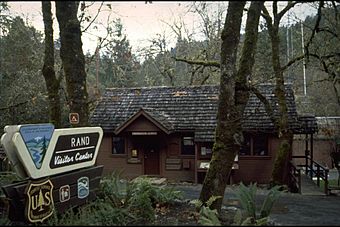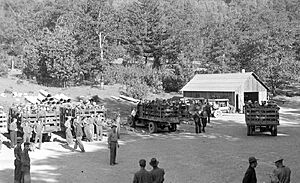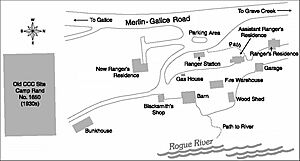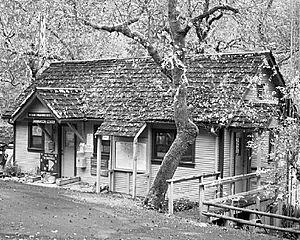Rand Ranger Station facts for kids
Quick facts for kids |
|
|
Rand Ranger Station
|
|

Rand Visitor Center
|
|
| Location | Rogue River-Siskiyou National Forest |
|---|---|
| Nearest city | Grants Pass, Oregon, USA |
| Built | 1931 -1936 |
| Architectural style | Oregon rustic |
| NRHP reference No. | 99000703 |
| Added to NRHP | 1999 |
The Rand Ranger Station is a special place in southwest Oregon. It has eight old buildings that are part of the Rogue River-Siskiyou National Forest. This station was first built by the United States Forest Service and a group called the Civilian Conservation Corps. It was used as a district ranger station for the Galice area.
Later, in 1970, the station was given to the Bureau of Land Management. Today, the old office building at Rand Ranger Station is a visitor center. This historic site is so important that it is listed on the National Register of Historic Places.
Contents
History of Rand Ranger Station
Early Days of the Forest Service
In 1906, President Theodore Roosevelt created the Siskiyou National Forest. A few years later, in 1909, six ranger districts were set up to manage different parts of the forest. The Galice Ranger District was in charge of the Rogue River canyon. Their jobs included selling timber, building trails, and fighting wildfires.
Jesse P. Dewitt was the first ranger for this district. For eight years, from 1909 to 1916, he had to live in a tent! This was because the Forest Service couldn't get permission to build a house for him at the Rand site. A local mining company owned the land. Finally, in 1916, the mining company agreed to rent a small piece of land to the Forest Service for just one dollar a year. Building started in 1917 for the ranger's house, the office, and a barn. In 1932, the mining company's claim on the land ended, and the Forest Service took full control of the station.
The Civilian Conservation Corps at Rand
The Civilian Conservation Corps (CCC) was a program started in 1933 to help young men find work during the Great Depression. That same year, a CCC camp, called Camp 1650, was set up at Rand. It started with 18 workers.
The CCC workers helped build roads and trails. They also created campgrounds in the forest. During the summer, these troops helped Forest Service employees fight wildfires.
The CCC built their own living areas and support buildings next to the Rand Ranger Station. Their camp eventually housed over 200 young men. They also made many improvements to the ranger station itself. This included fixing up old buildings and building new ones. They even improved the landscaping and built stone retaining walls around the site. The CCC camp at Rand closed in August 1941.
After World War II
After World War II, the Rand Ranger Station continued to be important for Forest Service work in the Rogue River canyon. The Rogue River became a very popular place for fishing, hiking, camping, and boating. In 1958, a new ranger house and a bunkhouse for seasonal workers were added.
In 1963, the Siskiyou National Forest closed the Rand Ranger Station. The Galice Ranger District headquarters moved to Grants Pass. The Rand complex was mostly empty for a while.
Bureau of Land Management Takes Over
In 1970, the Bureau of Land Management (BLM) took over the Rand property from the Forest Service. Since then, the BLM has used the site to give out permits for floating down the Rogue River. The river is a special place, officially called a National Wild and Scenic River.
In 1996, the BLM's visitor center, which is in the old ranger station office, was named the Smullin Visitor Center. This was to honor William B. Smullin, a well-known radio and television person from southern Oregon.
Even though all the buildings from the CCC camp are gone, the Forest Service buildings that the CCC helped build are still there and in good shape. The Rand Ranger Station looks much like it did when it was built. It offers visitors a look into the past. Because of its unique history and the rustic style of its buildings, the Rand compound was added to the National Register of Historic Places on June 10, 1999.
Buildings at Rand Ranger Station
The Rand Ranger Station has eight historic buildings and one other historic structure. All the buildings are made of wood. They include the district office, two ranger houses, a fire equipment warehouse, a blacksmith shop, a horse barn, a gas house, a garage, and a large woodshed. All these historic buildings were either built or improved by the CCC workers, guided by Forest Service rangers.
These buildings were built in a style called "Oregon rustic" between 1931 and 1936. The assistant ranger's house was built in 1931. The garage was built in 1933. The main office and the ranger's house were started in 1933 and finished in 1934. The barn, blacksmith shop, and gas house were built in 1934. The fire warehouse was built in 1935, and the woodshed in 1936.
The Rand Ranger Station office is now the visitor center. In 2004, the BLM made the visitor center bigger, adding more space to the building.
Besides the historic buildings, there are two newer buildings at the Rand Ranger Station. These are a third ranger house and a bunkhouse for workers, both built in 1958.
Location and Visiting Rand Ranger Station
The Rand Ranger Station is located in the Rogue River-Siskiyou National Forest. This is west of the Cascade Mountains in southern Oregon. It's about three miles north of a small community called Galice, Oregon. The station sits on a hillside above the Rogue River, about 735 feet above sea level.
To get to the Rand Ranger Station from Interstate 5, take the Merlin exit. This is north of Grants Pass, Oregon. Then, follow the Merlin-Galice Road west for about 19 miles. You will pass through the towns of Merlin and Galice. The Rand Ranger Station is on the east side of the Merlin-Galice Road, right by the Rogue River. You can park at the Smullin Visitor Center.
The Smullin Visitor Center is open to the public during the day from mid-May to mid-October. During the rest of the year, the hours can change, so the Bureau of Land Management suggests calling ahead. Visitors are welcome to take self-guided walking tours around the historic ranger station. However, the Smullin Visitor Center is the only building open to the public. If you want to go into other historic buildings, you need to ask a BLM employee for permission.








